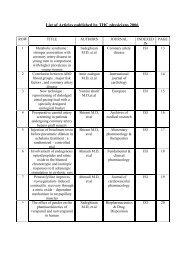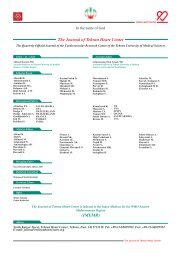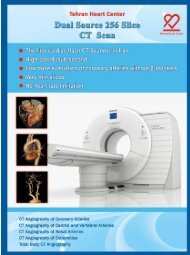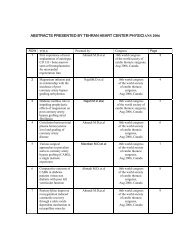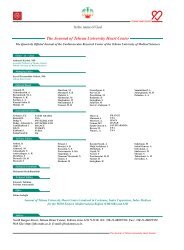Metabolic Syndrome: Stronger association With Coronary Artery
Metabolic Syndrome: Stronger association With Coronary Artery
Metabolic Syndrome: Stronger association With Coronary Artery
Create successful ePaper yourself
Turn your PDF publications into a flip-book with our unique Google optimized e-Paper software.
Arch Iranian Med 2006; 9 (2): 129 – 137<br />
Original Article<br />
A NOVEL SCORING SYSTEM FOR IDENTIFYING HIGH-RISK<br />
PATIENTS UNDERGOING CAROTID STENTING<br />
Seyed-Ebrahim Kassaian MD • *, Davood Kazemi-Saleh MD**, Mohammad Alidoosti MD*<br />
Mojtaba Salarifar MD*, Ali-Mohammad Haji-Zeinali MD*, Elham Hakki-Kazazi MD***<br />
Ali-Mohammad Sahraian MD † , Mohammad-Reza Gheini MD †<br />
Seyed-Hesameddin Abbasi MD***<br />
Background/Objective: In patients with severe concurrent coronary and carotid artery disease,<br />
two different treatment strategies may be used: simultaneous endarterectomy and coronary bypass<br />
surgery, and carotid stenting with delayed coronary bypass surgery after a few weeks. To evaluate<br />
the safety and efficacy of carotid stenting with delayed coronary bypass surgery after a few weeks in<br />
patients referred to Tehran Heart Center, Tehran, Iran and to determine the independent predictors<br />
that may be used to identify the appropriate treatment plan for such patients.<br />
Methods: This prospective study was performed from December 2003 through October 2004.<br />
Symptomatic patients with >60% stenosis and asymptomatic patients with >80% stenosis were<br />
included in this study. The risks and benefits of carotid stenting were explained. Patients were<br />
excluded from the study if any of the following was applicable: age 85 years, history of a major<br />
stroke within the last week, pregnancy, intracranial tumor or arteriovenous malformation, severely<br />
disabled as a result of stroke or dementia, and intracranial stenosis that exceeded the severity of the<br />
extracranial stenosis. Thirty consecutive patients who underwent carotid stenting were enrolled in<br />
this study.<br />
Results: The mean ± SD age of patients was 66.3 ± 8 years. The procedural success rate was<br />
96.7%. During a mean ± SD follow-up period of 5.6 ± 3.2 months, 4 (17%) deaths occurred; none of<br />
which were attributed to a neurologic causes. Moreover, 1 (3%) patient developed a minor nonfatal<br />
stroke with transient cognitive disorder. Most of patients (80%) with major complications acquired a<br />
score of 26.<br />
Conclusion: To reduce the rate of carotid stenting complications in high-risk patients with heart<br />
disease, to optimize the patient selections, and to determine the best treatment strategy, based on<br />
the clinical and lesion characteristics of patients, we proposed a new scoring system.<br />
Archives of Iranian Medicine, Volume 9, Number 2, 2006: 129 – 137.<br />
Keywords: Carotid arteries carotid endarterectomy carotid stenting scoring system<br />
Introduction<br />
Carotid and coronary artery occlusive<br />
disease frequently coexists as part of the<br />
systemic atherosclerotic process. 1, 2<br />
Carotid artery stenosis increases the risk of<br />
perioperative stroke in patients undergoing<br />
Authors’ affiliations: *Department of Interventional Cardiology,<br />
Tehran Heart Center, Tehran University of Medical Sciences,<br />
**Baghiatallah University of Medical Sciences, *** Research<br />
Department, Tehran Heart Center, † Department of Neurology,<br />
Tehran University of Medical Sciences, Tehran, Iran.<br />
•Corresponding author and reprints: Seyed-Ebrahim Kassaian<br />
MD, Research Department, Tehran Heart Center, North Kargar St.,<br />
P. O. Box: 1411713138, Tehran, Iran.<br />
Fax: +98-21-8029257, E-mail: kassaian@tehranheartcenter.org.<br />
Accepted for publication: 13 April 2005<br />
coronary artery bypass grafting (CABG). The<br />
management of severe coexisting disease poses a<br />
major dilemma. Surgical revascularization of one<br />
vessel is associated with an increased rate of<br />
complication in the others. 3 – 6 Staged and simultaneous<br />
surgeries of both vascular territories in these<br />
patients have been practiced at the expense of<br />
significant morbidity and mortality, mainly due to<br />
myocardial infarction and/or stroke. 3 – 6 Percutaneous<br />
elective carotid artery stenting (CAS) has been<br />
shown to be effective in treating severe occlusive<br />
carotid artery disease and may have its greatest<br />
benefit in patients with a high preoperative risk. 7, 8<br />
However, the clinical and anatomic heterogeneity<br />
Archives of Iranian Medicine, Volume 9, Number 2, April 2006 129



